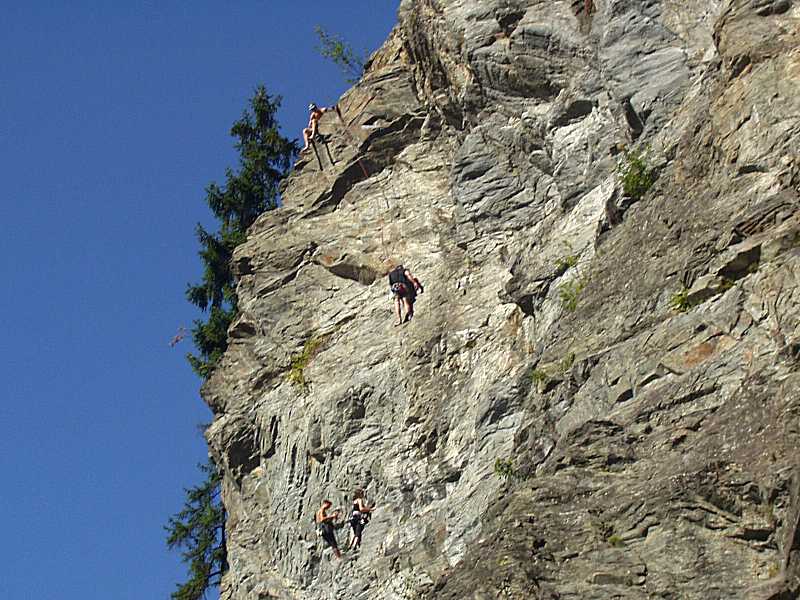|
Glacial Aretes
The
black lines you can see on the photo are glacial moraine. Moraine
is material transported by a glacier and then deposited. There are eight types
of moraine, six of which form recognizable landforms, and two of which exist
only whilst the glacier exists. The types of moraine that form landforms are
Ground, lateral, medial. push, recessional and terminal The two types only
associated with glacial ice are subglacial and englagial moraine.
Ground Moraine.
Ground moraine is till deposited over the valley floor. It has no obvious
features and is to be found where the glacier ice meets the rock underneath
the glacier. It may be washed out from under the glacier by meltwater streams,
or left in situ when the glacier melts and retreats.
Lateral Moraine
Lateral moraine forms along the edges of the glacier. Material from the valley
walls is broken up by frost shattering and falls onto the ice surface. It is
then carried along the sides of the glacier. When the ice melts it forms a
ridge of material along the valley side.
Push
Moraine
Push moraines are only formed by glaciers that have retreated and then advance
again. The existence of a push moraine is usually evidence of the climate
becoming poorer after a relatively warm period. Material that had already been
deposited is shoved up into a pile as the ice advances, and because most
morain material was deposited by falling down not pushing up, there are
characteristic differences in the orientation of rocks within a push moraine.
A key feature enabling a push moraine to be identified is individual rocks
that have been pushed upwards from their original horizontal positions.
Recessional
Moraine
Recessional moraines form at the end of the glacier so they are found across
the valley, not along it. They form where a retreating glacier remained
stationary for sufficient time to produce a mound of material. The process of
formation is the same as for a terminal moraine, but they occur where the
retreating ice paused rather than at the furthest extent of the ice.
Terminal
Moraine
The terminal moraine forms at the snout of the glacier. It marks the furthest
extent of the ice, and forms across the valley floor. It resembles a large
mound of debris, and is usually the feature that marks the end of unsorted
deposits and the start of fluvial sorted material.
Supraglacial
Moraine
Supraglacial moraine is material on the surface of the glacier, including
lateral and medial moraine, loose rock debris and dust settling out from the
atmosphere.
Englacial
Moraine
Englacial moraine is any material trapped within the ice. It includes material
that has fallen down crevasses and the rocks being scraped along the valley
floor.
Glacial terms
Firn (Nιvι) snow that accumulates to form ice
Nunataks Exposed summits in Ice sheets
Supraglacial debris - Eroded material on top of the glacier
Englacial debris - Eroded material in the middle of the glacier
Subglacial debris - Eroded material underneath the glacier
Frost Shattering Freeze thaw material that falls onto the glacier
Abraision (striations) Erosion of the valley floor by subglacial
debris
Plucking Glacier freezes onto loose rock and plucks it away when it
moves
Bergschrund the Crevasse at the head of the glacier in which melt
water collects
Rotational movement the erosion effect that causes Cirques
Arκtes formed by 2 adjacent cirques eroding backwards
Pyramidal
Peaks
formed by 3 or more adjacent cirques eroding backwards
Glacial Troughs flat valley floors
Ribbon lakes in glacial troughs
Truncated Spurs Ridges cut short by glaciers
Hanging valleys - Valleys cut by glaciers with waterfalls
Roche Moutonnee Resistant rock smooth one side with plucked crags
downstream
Rock Drumlins - Resistant rock smooth both sides Whalebacks
Till Drumlins Glacial till and debris in groups broad upstream long
and thin down
Terminal Moraines Glacial debris dumped at the end of a glacial
Lateral Moraines Glacial debris dumped at the side of a glacial
Medial Moraines Glacial debris from two lateral moraines when
glaciers meet
Kettle
Lakes
Depressions caused by large ice lump that then melted
Eskers lines of subglacial meltwater streams deposited debris
|
![]()
![]() (Website
design by Craig Moore, London, England)
(Website
design by Craig Moore, London, England)
